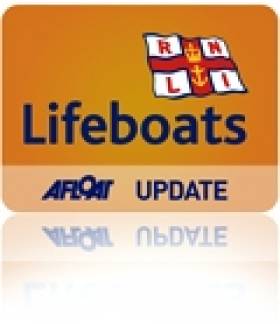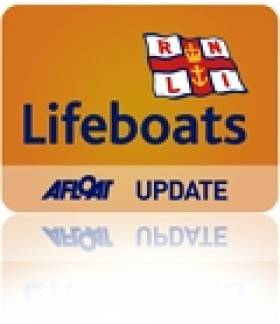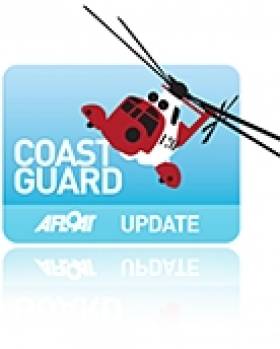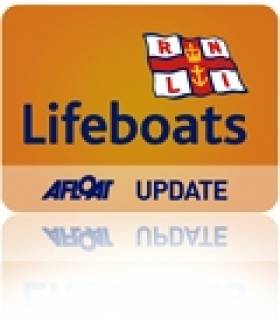Displaying items by tag: Lifeboat
Vessel Towed to Ballycotton Harbour by Lifeboat-Update
Ballycotton RNLI lifeboat launched today, 12 July, to lend assistance to a 40 foot pleasure craft that ran into difficulties one mile east of Ballycotton lighthouse. The pleasure craft fouled its propeller on rope while on passage and sought assistance. A lifeboat crewmember was put aboard the pleasure craft and attempts were made to free the offending rope but without success. A towline was established and the casualty was towed to Ballycotton harbour, where they arrived safely at 16:00.
Related Safety posts
RNLI Lifeboats in Ireland
Safety News
Rescue News from RNLI Lifeboats in Ireland
Coast Guard News from Ireland
Water Safety News from Ireland
Marine Casualty Investigation Board News
Marine Warnings
Ballycotton RNLI lifeboat launched this afternoon to a 40–foot pleasure craft which has a foulded propeller, a mile east of Ballycotton lighthouse in East Cork. They are on scene at present (15:14) and are attempting to free the propellor. Update to follow.
Lifeboat Towing Yacht to Ballycotton Harbour
Ballycotton RNLI lifeboat launched this evening at 17:15 to lend assistance to a 31 ft. yacht who sought assistance 4 miles east of Ballycotton in East Cork. The lifeboat arrived on-scene and established a towline at 17:50. The Irish registered yacht, with four persons aboard, is under tow to Ballycotton harbour. They are expected to arrive at approx. 18:45.
The Marine Institute is having a Summer Fête – Family Fun Pirate Day at its headquarters, Rinville, Oranmore on Sunday 11th July from 1.00 pm to 5.30 pm in aid of Galway Lifeboat. Admission is free.The fun day offers a great opportunity to meet friends, enjoy a range of cakes, tasty treats and a sausage sizzle courtesy of the Harbour Hotel, Kylemore Abbey and Compass Catering, while listening to live music overlooking Galway Bay. There will be items to purchase and a range of activities for all the family including face painting, cartoon classes, magic show, bouncy castles, art & crafts, marine displays and lots more fun activities and games."Since many of our staff go to sea on research surveys we appreciate the work done by the Galway Lifeboat and are anxious to help in any way we can," said Marine Institute CEO Dr. Peter Heffernan. "The event promises to be a fun-packed day for adults and children alike - particularly those who are interested in learning more about the work of the Marine Institute and the marine community in Galway".For those interested in viewing the architecture of the Institute's award winning building, tours will be available throughout the afternoon.The Marine Institute wishes to thank all of the exhibitors, sponsors and contributors taking part in the Summer Fête in aid of the Galway Lifeboats Ireland.All proceeds from the day will go to Galway Lifeboats.Further information is available on the Marine Institute's web site at www.marine.ie
The Marine Institute is having a Summer Fête – Family Fun Pirate Day at its headquarters, Rinville, Oranmore on Sunday 11th July from 1.00 pm to 5.30 pm in aid of Galway Lifeboat. Admission is free.
The fun day offers a great opportunity to meet friends, enjoy a range of cakes, tasty treats and a sausage sizzle courtesy of the Harbour Hotel, Kylemore Abbey and Compass Catering, while listening to live music overlooking Galway Bay. There will be items to purchase and a range of activities for all the family including face painting, cartoon classes, magic show, bouncy castles, art & crafts, marine displays and lots more fun activities and games.
"Since many of our staff go to sea on research surveys we appreciate the work done by the Galway Lifeboat and are anxious to help in any way we can," said Marine Institute CEO Dr. Peter Heffernan. "The event promises to be a fun-packed day for adults and children alike - particularly those who are interested in learning more about the work of the Marine Institute and the marine community in Galway".
For those interested in viewing the architecture of the Institute's award winning building, tours will be available throughout the afternoon.
The Marine Institute wishes to thank all of the exhibitors, sponsors and contributors taking part in the Summer Fête in aid of the Galway Lifeboats Ireland.
All proceeds from the day will go to Galway Lifeboats.
Further information is available on the Marine Institute's web site at www.marine.ie
Pwllheli RNLI Lifeboat Assists Yacht Bound for Cork
Pwllheli's RNLI all weather lifeboat was launched on Monday evening to assist a yacht which was drifting towards the shore.
The 37ft vessel with two people on board suffered engine failure around a mile south of the town and an attempt was made to lay the anchor but the rope entangled in the propellor.The lifeboat was launched soon after 10pm after flares were sighted being fired from the yacht.
A strong south westerly wind was pushing the yacht towards Gimblet Rock and it was around half a mile from the rock when located by the all weather lifeboat. The vessel, which was on passage from Pwllheli to Cork, was towed to the marina by the RNLI lifeboat.
Baltimore Lifeboat Search for Missing Man
The RNLI Inshore Lifeboat Bessie was called to assist in a search for a man who failed to make a pre-arranged meeting with a friend in Baltimore yesterday. The man had been camping on the Islands of Roaring Water Bay, and had left his Jeep in Baltimore. When the alert was raised at 20:18, it was unclear where the man might have been intending to stay that night. A search was initiated by Helmsman John Kearney and crewmen Micheal Cottrell and Paul O’Driscoll extending from Barlogue Creek at the mouth of Lough Hyne and into Roaring Water Bay. The Schull inshore lifeboat and the Coast guard helicopter were also involved in the search. The search was stood down last night as darkness fell and recommenced this morning at 05:15 with Helmsman Kieran Collins and crewmen Ronan Sheehy and Jim Baker on board the RNLI inshore lifeboat Bessie.
Man Dragged from Capsized Dinghy at Newtownards Sailing Club
At around 11.45 this morning Belfast Coastguard received an urgent call for assistance to the Newtownards sailing club where four people were in difficulty, two of them children. One man is unconscious, and in a poor way.
An upside down Lazer 2000 dinghy was spotted by a sailing instructor who went to render assistance to those in the water. The crew of a further incoming rigid inflatable boat also helped.
A man in his 50s was then pulled from the water and brought ashore. He is in a very poor way and cardio pulmonary resuscitation has been administered both in the incoming vessel and ashore. The second adult who had been in the upturned dinghy also assisted. Two children who were also in the water are cold, wet and in a state of shock but otherwise unharmed. All four were wearing lifejackets but the lifejacket on the casualty did not inflate.
The Portaferry inshore lifeboats were launched plus the Bangor Coastguard Rescue Team attended. Local police were also in attendance. An ambulance is also on scene.
Rob Steventon, Watch Manager at Belfast Coastguard said
"Along with the Police we are still gathering further details, but we do not know as yet how long the dinghy had been upturned or how long they had been in the water as the first report was by someone who was going out on to the water and had seen the hull of the craft.
"We urge boaters strongly to check their life saving equipment and general safety equipment to ensure everything is working correctly. The Marine Accident Investigation Branch has been informed."
UK Coastguard Now Has 40,000 Beacons on its Register
The UK 406 EPIRB Registry based at MRCC Falmouth reached a new milestone this month by registering their 40,000th beacon, meaning the database has doubled in size in three years. The team has worked tirelessly to provide good customer service and maintain operationally valid records and as such the Registry is well respected throughout the SAR world.
The importance of the 406 MHZ beacon was highlighted by the safe rescue of four people from the Yacht Hollinsclough in the deep Southern Atlantic recently. The vessel had two correctly registered beacons which supplied key data to both national and international search and rescue authorities.
Steve Huxley, SAR Communications Manager said:
If you are a boat owner, consider buying an emergency beacon as part of the life- saving equipment fit to your vessel.
Emergency Position Indicating Radio Beacons have proved many times that they have contributed to the saving of lives.
999 call prompts rescue of six men off Swansea
Swansea Coastguard called out the Mumbles Coastguard Rescue team and requested the launch of the Mumbles RNLI inshore lifeboat.
The lifeboat upon reaching the drifting vessel discovered the craft was carrying six men of chinese origin, it was taking on water due to the boat having no bung, and there was no lifesaving equipment whatsoever.
The South Wales police were alerted to the incident and despatched a unit to question the men. The six men are being interviewed by the police.
Dai Jones, Watch Manager, Swansea Coastguard said:
If we had not been alerted to this drifting vessel by the member of the public, this incident could so easily have had a different outcome.
The vessel was drifting towards where the tide flows extremely fast and it would have carried this craft and it's six occupants to extreme danger.
As the vessel was taking water and not a lifejacket between them, we could easily have been looking at a fatal incident.
Lifeboats Rescue Man Overboard off Antrim Coast
On a busy Sunday for RNLI lifeboat crews off the north Antrim Coast both Red Bay and Portrush RNLI lifeboat crews launched at 9.22am this morning to reports of a vessel in difficulty with two people onboard off Sheep Island at Ballintoy.
The 16 foot fishing boat got into difficulties when an anchor went down and a crewmember from the vessel bent over the bow of the boat in an attempt to retrieve it. He was caught by a wave and pulled into the freezing water.
When the lifeboats arrived on scene the man had been recovered onto the vessel by the other crewmember. Conditions were poor with a force five in evidence and a big swell. Both men were suffering from the cold and were in shock. The vessel was clearly in great difficulty and the two men were transferred onboard the Portrush all weather lifeboat while Red Bay RNLI towed the vessel back to land. A waiting ambulance met the casualties at Ballycastle.

Commenting on the rescue Red Bay RNLI helm Paddy McLaughlin said, “These two men were extremely lucky today. One man had already entered the freezing water before getting back on the boat and they were both in need of medical assistance by the time we had reached them.”
The rescue operation lasted for three hours and was the second major rescue for the RNLI in the area that morning. Portrush RNLI inshore lifeboat crew rescued two men from the sea while their all weather lifeboat assisted Red Bay with the Ballintoy callout.
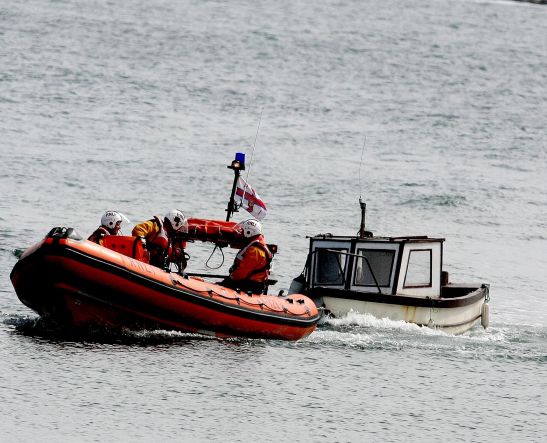
Additional report from MCA:
The emergency 999 call was made at 9.15 this morning alerting the marine emergency service and that the cruiser with two people on board was in extreme difficulty and without power.
The Coastguard immediately relayed a mayday signal into the area to alert other vessels to the on going emergency.
The Portrush and Redbay lifeboats were also asked to launch and a rescue helicopter was initially scrambled from the Royal Naval Air Station at Prestwick, however by this time the man had been recovered to the vessel and it was stood down. His colleagues on board the cabin cruiser indicated that he was very cold but there were no visible injuries and that he was slowly warming up, but they remained without power as a rope had been caught around its propeller and were experiencing very heavy weather. The Portrush all weather lifeboat picked up the man who gone into the water and a colleague and brought them will all speed back to Ballycastle. The Redbay lifeboat is now bringing the vessel under tow back to Ballycastle.
Meanwhile a further call was taken from Portrush promenade where a member of the public had spotted two people in the water shouting for help. Both were drunk and had been caught in the rip tide off West Strand. The Coastguard began broadcasting into the area immediately requesting vessels to go to his assistance and the Portrush inshore lifeboat was on scene very quickly and recovered both people to the lifeboat. An ambulance was requested and the lifeboat was met by the Coleraine Coastguard Rescue Team and paramedics.
Alan Pritchard, Duty Watch Manager at Belfast Coastguard said:
“It is clear that the weather is going to be somewhat rough today with rain forecast. We are asking the boating public and those who will be visiting the coastline to take that extra bit of care. Make sure you have some communication with you, and of course if you go afloat wear a lifejacket! The two men who went into the water whilst under the influence of drink are very poorly in hospital, and we cannot stress enough how dangerous it is going into the sea whilst drinking.”




























